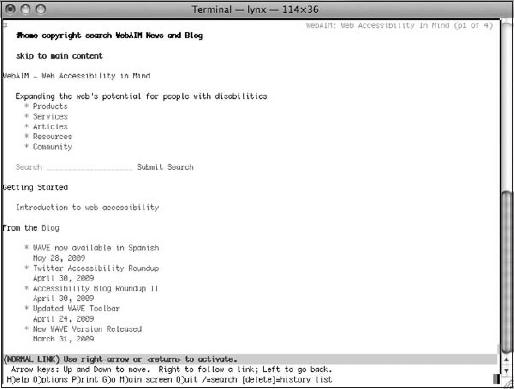9.8. Assistive Technology
One of the best ways to test for accessibility is to use the assistive technology tools.
9.8.1. Text-Based Browsers
Text browsers are great tools for checking the text on web applications. With text browsers you can see exactly what text is rendered, what order the text is in, and check the navigation elements.
9.8.2. Lynx
Lynx (http://lynx.isc.org/) is an open source (free) text-based browser. Lynx was originally developed in 1992 at the University of Kansas and is available for many platforms, such as Windows, Mac, and various versions of Unix. Figure 9-32 shows what the Web AIM looks like, rendered using the Lynx text browser. Notice the clean look of the formatting, and placement of the "Skip Navigation" link.
9.8.3. Screen Readers
Screen readers are one of the most popular assistive technologies used. When people think of screen readers, the disability that first comes to mind is blindness. A survey conducted by WebAIM in January 2009 shows that blindness is not the only disability that utilizes screen readers. Of the people surveyed the following percentages reported use of screen readers:
Blindness — 80.1 percent
Low vision/visually impaired — 15.8 percent
Cognitive — .7 percent
Deafness/hard of hearing — 4.2 percent
Motor — 2.1 percent
No disability — 5.4 percent
Figure 9-32. Lynx text browser

9.8.3.1. JAWS
Job Access With Speech (http://www.freedomscientific.com/products/fs/jaws-product-page.asp ...
Get Testing ASP.NET Web Applications now with the O’Reilly learning platform.
O’Reilly members experience books, live events, courses curated by job role, and more from O’Reilly and nearly 200 top publishers.

